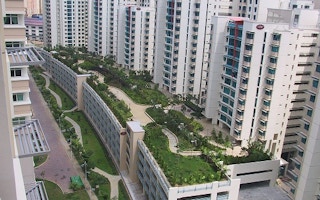Rooftop rain gardens are relatively inexpensive and can hold large amounts of water. And if the authorities accept a recommendation by an expert panel on floods to mandate that all buildings have these green roofs, they can be quick to install, too.
The 12-man panel, tasked by the Government to look into solving Singapore’s flooding woes in the long run, has recommended that building owners be required by law to build green roofs. These rooftop gardens, traditionally installed to beautify the skyline and reduce the heat around a building, can help absorb rainwater and reduce the speed of water flow.
Local contractors The Straits Times interviewed yesterday said these gardens would cost from $20,000 to $180,000, depending on their size.
Property developer City Developments, a leader in green buildings here, spends $150 to $400 per sq m for a green roof for a new building, and $105 to $150 per sq m to retrofit an existing one. For a residential project with an extensive green roof, installation generally does not exceed 1 per cent of total construction cost, it said.
Contractors say such gardens can store anything from about six to 34 litres per sq m. The size can range from 200 sq m for a commercial building, to 1,200 sq m for the entire roof of a multi-storey Housing Board carpark.
The National Parks Board (NParks) said the cost of such gardens is usually between $100 and $150 per sq m, which means a commercial green roof costs between $20,000 and $30,000 and can hold 6,800 litres. An HDB carpark roof costs $120,000 to $180,000 and can hold 40,800 litres of water.
Mr Andy Chew, director of local firm Elmich, which designs, builds and installs green roofs, said the idea of rooftop gardens to help alleviate flooding could work for Singapore as large amounts of rainwater can be stored in the garden’s water retention system.
This comprises soil-like material, membranes and storage trays. The water is then eventually absorbed by the plants as they grow. He added that the soil-like material also helps to regulate the flow of water; therefore, the speed of any excess water that flows down to ground level is reduced. The system is also light and can typically be installed in an average building.
Elmich, which has been in the business for 26 years and has installed gardens such as the one atop Orchard Central mall, offers systems that can store between six and 28 litres per sq m.
Another firm, Prince’s Landscape & Construction, offers a proprietary solution whose water reservoir feature can store up to 34 litres of water per sq m.
Its manager Eugine Spicer said its roof gardens can help alleviate flooding as ‘the sudden flow of water is minimised’. Depending on the size of the project and whether there is easy rooftop access, installing a green roof of about 400 sq m could take a month. Growing the plants takes two to three months before that, said Mr Spicer.
Prince has installed green roofs for properties such as Marina Bay Sands, and typically installs gardens 500 sq m in size at a cost of $150 per sq m.
NParks deputy director of horticulture and community gardening Ng Cheow Kheng told The Straits Times that to date, 36ha of skyrise greenery - greenery planted on rooftops or vertically on walls - have already been installed in buildings across Singapore.
NParks has a Skyrise Greenery Incentive Scheme which pays for half of installation costs, up to a maximum of $75 per sq m of green roof and $750 per sq m of green wall. Since the scheme launched in 2009, it has seen 40 buildings get fitted with 1.1ha of green roofs and 0.1ha of green walls.
Under the Building and Construction Authority’s green building rating scheme Green Mark, buildings that feature such green roofs get extra points.
HDB has also piloted green roofs in existing housing blocks in recent years to reduce heat build-up and slow down stormwater. Its first eco-friendly residential project, Treelodge@ Punggol, features a rain-harvesting system where water collected is put to uses such as washing common areas.
PUB said it is studying the recommendations of the expert panel and will respond at a later date.
Benefits of rooftop gardens
A Green roof, also known as a rooftop garden or rain garden, is a roof that is partially or completely covered with plants and provided with an irrigation system.
Such greenery reduces the ‘urban heat island’ effect which makes a built-up area significantly warmer than its surroundings.
Green roofs also:
- Conserve energy use in the building by keeping temperatures down so less air-conditioning is needed;
- Improve air quality;
- Reduce noise pollution;
- Enhance a building’s aesthetics;
- Store rainwater and reduce the amount and speed at which water flows to the ground.
This article originally appeared in The Straits Times.










